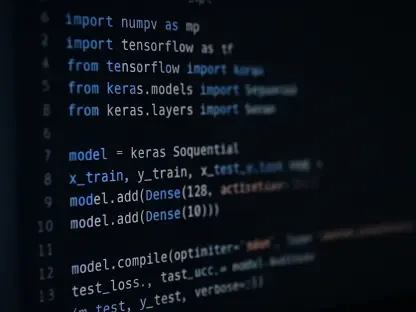Artificial intelligence (AI) is revolutionizing various sectors, from healthcare to finance, making it crucial for professionals to understand the tools and languages used in AI development. This article delves into the programming languages that are most effective for AI, machine learning (ML), and deep learning (DL) solutions, particularly for beginner programmers. AI development involves creating interconnected algorithms designed to perform specific tasks. Unlike traditional algorithms, AI algorithms learn and adapt through iterations, improving over time. The process starts with designing an algorithmic workflow that mimics human-like information processing. This initial AI model undergoes training on relevant datasets, learning to recognize data patterns and enhancing its problem-solving accuracy through iterations. A cost function guides this iterative training process, evaluating the efficiency of the algorithm’s solutions.
Once sufficiently trained, the model can be deployed for practical use, often surpassing human efficiency and accuracy. AI programming languages, coupled with specialized frameworks, are essential in creating these complex algorithms. Frameworks built on existing programming languages offer unique functionalities that simplify AI algorithm development.
Python: The Go-To Language for AI Development
Python stands out as the most popular choice for AI programming due to its readable and easy-to-learn syntax, making it accessible to both beginners and experienced developers. Its versatility allows it to be used across various applications, from web development to AI algorithms. Python’s extensive library support is a significant advantage, with notable AI libraries including TensorFlow, SciKit-Learn, and Pybrain. TensorFlow, developed by Google, is an open-source library designed for machine learning tasks, particularly neural networks. Its capability to parallelize workloads and scale efficiently makes it a preferred tool among AI practitioners. SciKit-Learn focuses on data-related tasks such as classification, model selection, and preprocessing, making it especially useful in data mining and analysis. Pybrain, short for Python-Based Reinforcement Learning, Artificial Intelligence, and Neural Network Library, is modular and beginner-friendly, allowing quick implementation of AI algorithms.
Python’s community support further strengthens its position as a leading language for AI development. Numerous online resources, tutorials, and forums are available for new learners, providing a supportive environment for mastering AI concepts. Polished documentation for Python’s libraries ensures that developers can efficiently troubleshoot issues and explore advanced functionalities.
R: A Powerful Tool for Data Science and AI
R is a programming language commonly used in data science, making it suitable for AI applications involving extensive data processing and statistical analysis. It offers robust capabilities for linear and nonlinear modeling, time-series analysis, clustering, and visualization. However, R’s steep learning curve makes it less ideal for beginners, though it is valuable in enterprise settings with large data requirements. R’s strength lies in its ability to handle complex data analysis tasks, making it a preferred choice for statisticians and data scientists. Its comprehensive library ecosystem, including packages like caret and randomForest, provides powerful tools for building and evaluating machine learning models. Despite its complexity, R’s capabilities in handling large datasets and performing intricate statistical analyses make it an indispensable tool in the AI developer’s toolkit.
Additionally, R’s integration with other programming languages and tools enhances its appeal for AI development. It can seamlessly work with databases, connecting to data sources for efficient data retrieval and analysis. Furthermore, R’s visualization capabilities are unparalleled, offering a wide range of plotting and graphing options to help developers and analysts interpret data effectively.
Java: Reliable and Versatile for AI Programming
Java’s “write once, run anywhere” philosophy, along with minimal dependencies, makes it a reliable choice for AI programming. The language’s Java Virtual Machine (JVM) facilitates portability across different platforms. Java’s notable AI libraries include Deeplearning4j and Neuroph, which support deep learning and neural network tasks, respectively. Java’s strong data processing capabilities make it suitable for managing data pipelines in corporate environments. Deeplearning4j is an open-source, distributed deep learning library for Java and Scala, designed to be used in business environments on distributed GPUs and CPUs. Neuroph, on the other hand, is a lightweight Java neural network framework that provides a simple API for creating and training neural networks. Java’s robust ecosystem and extensive community support make it a solid choice for AI development, particularly in enterprise settings.
Java’s robust integrability with large-scale enterprise systems makes it an excellent choice for AI solutions in corporate environments. Organizations can leverage Java to build AI-powered tools and applications that seamlessly integrate with existing infrastructure. Furthermore, Java’s mature ecosystem, characterized by reliable frameworks and libraries, supports highly efficient and scalable AI development.
Scala: Enhancing Java for AI Development
Scala, designed to enhance Java while retaining compatibility with JVM, offers improved concurrent operation capabilities, allowing for efficient parallel processing of compute-heavy tasks. Its syntax is similar to Java, and it can leverage the entire JVM ecosystem. Scala’s ease of integration with Java libraries makes it an attractive option for developers familiar with Java. Scala’s functional programming features, combined with its object-oriented capabilities, provide a powerful toolset for AI development. Libraries like Breeze and Spark MLlib offer robust support for machine learning tasks, making Scala a versatile choice for AI practitioners. Scala’s ability to handle large-scale data processing and its seamless integration with existing Java infrastructure make it a valuable asset in the AI development landscape.
Scala’s ability to operate efficiently with Big Data technologies positions it favorably for AI applications that demand extensive data processing capabilities. The language’s compatibility with Apache Spark, a robust open-source distributed computing system, allows developers to process large datasets effectively. This, combined with Scala’s concise syntax, enhances developers’ productivity and performance in AI projects.
C++: High Performance for Low-Power AI Applications
C++ is a powerful, general-purpose programming language known for its compiled nature, which allows direct communication with the CPU, resulting in reduced computational delays. It is particularly useful for AI applications on low-computing power devices such as IoT devices and autonomous vehicles. However, C++’s steep learning curve and limited library support for specialized AI tasks restrict its broader adoption in the AI field. Despite its challenges, C++ offers unparalleled performance and control over system resources, making it ideal for resource-constrained environments. Libraries like Dlib and Shark provide support for machine learning tasks. These libraries offer effective solutions for developing high-performance AI algorithms suitable for applications where computational efficiency is paramount.
C++’s performance benefits extend beyond low-power applications to scenarios requiring real-time data processing and analysis. For example, in robotics and autonomous driving, where swift decision-making is critical, C++ can powerfully execute AI algorithms with minimal latency. C++’s rich history in competitive programming and systems development gives it a tangible edge in optimizing AI solutions for high-stakes, real-world applications.
Emerging Trends and Perspectives
The AI programming landscape continues to emphasize accessibility and ease of learning, as seen with the rising popularity of Python and its vast library ecosystem. Python’s simplified syntax and robust community support make it the top choice for beginners. On the other hand, languages like R and C++ are tailored for more specialized and demanding tasks, often found in enterprise environments or low-power devices.
A notable trend is the focus on interoperability and integration. Languages like Scala enable seamless integration with Java ecosystems, while Lisp gains traction in research-oriented AI projects due to its powerful capabilities. However, Lisp’s complexity and difficulty integrating with game development tools limit its broader appeal. Overall, Python is highly valued for its beginner-friendly nature, extensive library support, and versatility in various AI applications.
Training AI models is an iterative process guided by cost functions, ensuring they continually improve in problem-solving. Unlike traditional programming, AI programming involves complexity and autonomous learning aspects. Frameworks play a critical role in simplifying development, making Python the favored language for beginners and general AI development. Its readability, simplicity, and extensive libraries give it an edge. Meanwhile, R, Java, Scala, and C++ offer unique advantages for specific AI applications, from data science to enterprise solutions and low-power device deployments.
In conclusion, the analysis of AI programming languages reveals a diverse array of tools suited to different use cases and expertise levels. The prevailing trend leans towards languages that are easy to learn, have strong library support, and are flexible in their applications. With Python at the forefront, the field of AI is set for ongoing advancements, further simplifying development and broadening accessibility.









